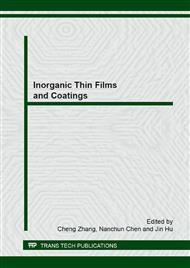[1]
A. K Geim, K. S. Novoselov, The rise of graphene Nature Materials 6 (2007) 183-191.
Google Scholar
[2]
Allen MJ, Tung VC, Kaner RB, Honeycomb Carbon: A Review of Graphene, Chem. Rev, 110 (2010) 132–145.
DOI: 10.1021/cr900070d
Google Scholar
[3]
H.C. Schniepp, J.L. Li, M.J. McAllister, Functionalized Single Graphene Sheets Derived from Splitting Graphite Oxide, J. Phys. Chem. B 110 (2006) 8535-8539.
DOI: 10.1021/jp060936f
Google Scholar
[4]
D.C. Marcano, D.V. Kosynkin, Improved Synthesis of Graphene Oxide, ACS Nano, 4.8.(2010) 4806–4814.
Google Scholar
[5]
D. Pan, S. Wang, B. Zhao, Li Storage Properties of Disordered Graphene Nanosheets, Chem. Mater. 21 (2009) 3136-3142.
DOI: 10.1021/cm900395k
Google Scholar
[6]
P. Guo, H. Song, X. Chen, Electrochemical performance of graphene nanosheets as anode material for lithium-ion batteries, Electrochem. Commun. 11 (2009) 1320-1324.
DOI: 10.1016/j.elecom.2009.04.036
Google Scholar
[7]
A. Fasolino, J.H. Los, M.I. Katsnelson, Intrinsic ripples in graphene. Nat. Mater. 6 (2007) 858-861.
DOI: 10.1038/nmat2011
Google Scholar
[8]
Y. Wu, C. Jiang, C. Wan, E. Tsuchida, Effects of catalytic oxidation on the electrochemical performance of common natural graphite as an anode material for lithium ion batteries, Electrochem. Commun. 2 (2000) 272-275.
DOI: 10.1016/s1388-2481(00)00022-9
Google Scholar
[9]
T. Zheng, J. S. Xue, and J. R. Dahn, Lithium Insertion in Hydrogen-Containing Carbonaceous Materials, Chemistry of Material. 8 (1996) 389-393
DOI: 10.1021/cm950304y
Google Scholar
[10]
L. Li, E. Liu, Y.Yang, Nitrogen-containing carbons prepared from polyaniline as anode materials for lithium secondary batteries, Materials Letters. 64 (2010) 2115-2117.
DOI: 10.1016/j.matlet.2010.06.057
Google Scholar
[11]
A. Concheso, R. Santamaría, R. Menéndez, Electrochemical improvement of low-temperature petroleum cokes by chemical oxidation with H2O2 for their use as anodes in lithium ion batteries, Electrochim. Acta 52 (2006) 1281-1289.
DOI: 10.1016/j.electacta.2006.07.029
Google Scholar
[12]
P. Lian, X. Zhu, S. Liang, Large reversible capacity of high quality graphene sheets as an anode material for lithium-ion batteries Electrochimica Acta 55 (2010) 3909-3914
DOI: 10.1016/j.electacta.2010.02.025
Google Scholar
[13]
J.L. Tirado, G.F. Ortiz, I. Honma, Tin–carbon composites as anodic material in Li-ion batteries obtained by copyrolysis of petroleum vacuum residue and SnO2 Carbon. 7 (2007) 1396-1409.
DOI: 10.1016/j.carbon.2007.03.041
Google Scholar



